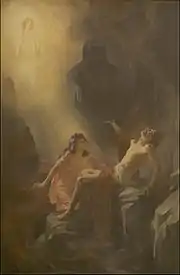| Part of a series on |
| Paranormal |
|---|
The Guardian of the Threshold is a menacing figure that is described by a number of esoteric teachers.[1][2][3][4] The term "Guardian of the Threshold", often called "Dweller on the Threshold", indicates a spectral image which is supposed to manifest itself as soon as "the student of the spirit ascends upon the path into the higher worlds of knowledge".[5][6][7] The Guardian of the Threshold is also the title of the third play (of a tetralogy of Mystery Dramas) written by Rudolf Steiner in 1912.
According to theosophy

The "Dweller of the Threshold" (or "Guardian of the Threshold") as a literary invention of the English mystic and novelist Edward Bulwer-Lytton is found in his romance Zanoni (1842). After the founding of the Theosophical Society in 1875, the term gained wide currency in theosophical circles. The Guardian of the Threshold is a spectral figure and is the abstract of the debit and credit book of the individual. "It is the combined evil influence that is the result of the wicked thoughts and acts of the age in which any one may live, and it assumes to each student a definite shape at each appearance, being always either of one sort or changing each time"[8] "This Dweller of the Threshold meets us in many shapes. It is the Cerberus guarding the entrance to Hades; the Dragon which St. Michael (spiritual will-power) is going to kill; the Snake which tempted Eve, and whose head will be crushed by the heel of the woman; the Hobgoblin watching the place where the treasure is buried, etc. He is the king of evil, who will not permit that within his kingdom a child should grow up, which might surpass him in power; the Herod before whose wrath the divine child Christ has to flee into a foreign country, and is not permitted to return to his home (the soul) until the king (Ambition, Pride, Vanity, Self-righteousness, etc.) is dethroned or dead."[9] According to Max Heindel, the Dweller on the Threshold must be confronted by every aspirant—usually at an early stage of his progress into the unseen worlds—and is one of the main causes of obsession.[10]
In Rudolf Steiner's drama
In Rudolf Steiner's play The Guardian of the Threshold, first performed in 1912 and the third in a series of four "Mystery Dramas", the appearance of the Guardian is connected with Lucifer and Ahriman. Steiner explained that the meeting with the Guardian of the Threshold as presented in those dramas was to show that a person (man or woman) who had made the soul clairvoyant, must go back and forth across that threshold and know how to be rightly in the spiritual world on the far side, as well as on this side in the physical world.[11]
See also
References
- ↑ Madame Blavatsky, Isis Unveiled, 1877
- ↑ Rudolf Steiner, “Knowledge of the Higher Worlds”(1904-5), Online English edition (1947, New York) and An Outline of Occult Science first German edition 1909. Online English edition (1972, New York), chapter 5
- ↑ Dion Fortune, “The Mystical Qabalah”, 1950
- ↑ Samael Aun Weor, "The Perfect Matrimony", 1950
- ↑ Franz Hartmann, The Dweller of the Threshold, Reprinted from The Theosophist, Vol. XI 1889
- ↑ Rudolf Steiner, An Outline of Occult Science, Anthroposophic Press 1972
- ↑ Tommaso Palamidessi, The Guardians of the Threshold, ed. Archeosofica, 1969
- ↑ Eusebio Urban, Path, December, 1888
- ↑ Franz Hartmann, The Dweller of the Threshold, Reprinted from The Theosophist, Vol. XI 1889
- ↑ Max Heindel, The Web Destiny, Rosicrucian Fellowship
- ↑ Rudolf Steiner, Secrets of the Threshold, VII
External links
- The Guardian of the Threshold excerpt from An Outline of Occult Science by Rudolf Steiner
- The Guardian of the Threshold - a play by Rudolf Steiner
- The Perfect Matrimony by Samael Aun Weor (see Chapter 19 'Initiation')
